The 10 Best Rear Delt Exercises for Mass and Hypertrophy

Many lifters don’t give much thought to training their rear delts.
While the side and front delts tend to get a lot of attention, the rear delts are often ignored because . . . well, out of sight usually means out of mind.
This is a mistake.
Training your rear delts properly not only makes your shoulders look more aesthetic, it may also reduce your risk of injury and improve your athletic performance.
In this article you’ll learn what the rear delts are, why it’s important to train them, four tips to make your rear delt training as effective as possible, and the best rear delt exercises for mass and strength.
- Table of Contents
- What Are the Rear Delts?
- Rear Delt Training Tips
- 1. Do the right rear delt-focused exercises.
- 2. Train your rear delts with 10-to-20 sets per week.
- 3. Try to add weight or reps to every exercise in every workout.
- 4. Prioritize rear delt exercises.
- The 10 Best Rear Delt Exercises for Mass
- 1. Barbell Row
- 2. One-Arm Dumbbell Row
- 3. Pull-up
- 4. Chin-up
- 5. Lat Pulldown
- 6. Seated Cable Row
- 7. Barbell Rear Delt Row
- 8. Dumbbell Rear Lateral Raise
- 9. Machine Reverse Fly
- 10. Face Pull
- FAQ #1: What is the best exercise for rear delts?
- FAQ #2: Can I do rear delt exercises at home?
- FAQ #3: What are the best front, side, and rear delt exercises?
What Are the Rear Delts?
The deltoid muscles—or “delts”—are the muscles that cover your shoulder joints and help your upper arms move forward, upward, and backward.
Each deltoid is made up of three sections or “heads:” the anterior deltoid, the lateral deltoid, and the posterior deltoid.
Here’s how they look on your body:
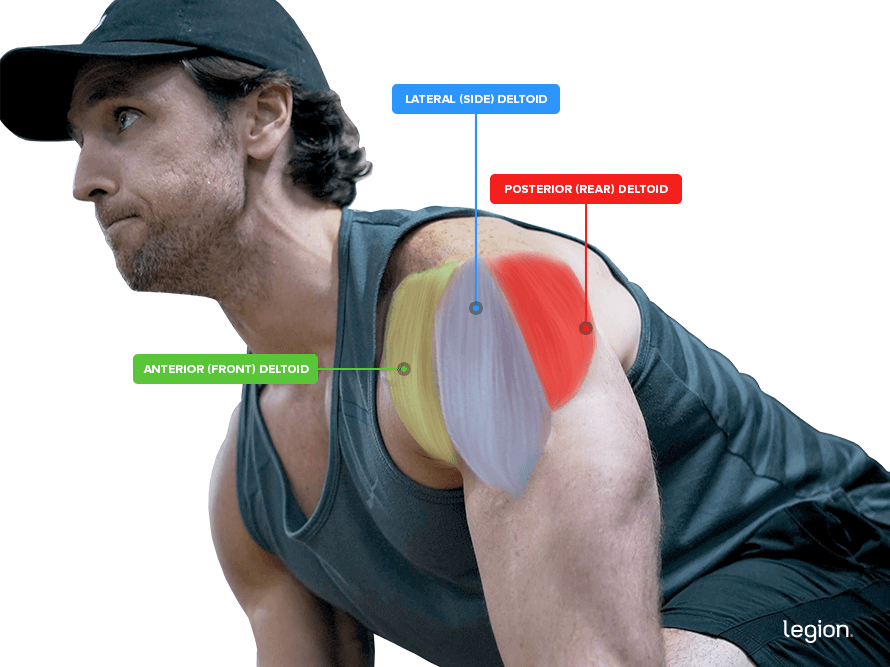
The posterior deltoids are better known among weightlifters as the “rear delts” because, as the name suggests, they’re located behind your shoulder joints on your upper back.
Training your rear delts offers two important benefits:
1. It ensures that your shoulders are proportional.
The rear delts are smaller and more stubborn than the other heads of the deltoids, which means they often need a bit of extra attention in the form of good rear delt exercises if you want them to grow at the same rate as your front and side delts.
2. It improves the health of your shoulders.
Many weightlifters spend more time training their front and side delts with pushing exercises like the bench press, overhead press, and lateral raise, than they do training their rear delts with pulling exercises like the barbell row, pull-up, and lat pulldown.
Over time this can cause a strength and size imbalance between your rear delts and your front and side delts, which may increase your risk of injury.
Rear Delt Training Tips 1. Do the right rear delt-focused exercises.
The “secret” to building well-developed rear delts is to get as strong as possible on compound exercises that train your rear delts.
This means you should spend the majority of your time in the gym doing variations of pull-ups, pulldowns, and rows.
That said, if you want to maximize rear delt growth, research shows that it’s worth doing isolation exercises that emphasize your rear delts, too (more on which exercises are most effective soon).
A good rule of thumb is that 80% of your time and energy should go into compound exercises that train your rear delts, and the remaining 20% you can give to rear delt isolation exercises and machines.
2. Train your rear delts with 10-to-20 sets per week.
To develop any major muscle group, including your rear delts, it’s generally best to train it with 10-to-20 weekly sets.
People who’ve been following a proper strength training program for less than two years should aim for 10-to-15 weekly sets, whereas those who’ve been training properly for more than two years should aim for 15-to-20 weekly sets (if you want to maximize growth, that is).
Doing 10-to-15 sets in a single workout should be tough, but not too tough.
If you’re doing upward of 15 weekly sets, though, you’ll probably find that the quality of your sets begins to suffer as you get deeper into your workout. This is why it’s normally better for more advanced weightlifters to divide this volume (number of sets) over at least two workouts per week.
3. Try to add weight or reps to every exercise in every workout.
If you stop getting stronger, your rear delts will eventually stop getting bigger (this applies to every major muscle group in the body).
The best way to get strong and build muscle is to ditch the high-rep “pump” training and lift heavy.
By “heavy,” I mean doing most of your exercises with weights in the range of 75-to-85% of your one-rep max (1RM), or in the range of 8-to-10 (~75%) to 4-to-6 (~85%) reps.
You should also strive to add weight or reps to every exercise in every workout. This is known as progressive overload, and it’s one of the best ways to maximize the muscle-building effects of weightlifting.
4. Prioritize rear delt exercises.
Studies show that you make the fastest progress on muscle groups that you train at the beginning of your workouts.
Thus, if you want to give yourself the best opportunity to improve your rear delt development, shift exercises that emphasize your rear delts to the start of your back, push pull, or upper-body workouts.
The 10 Best Rear Delt Exercises for Mass 1. Barbell Row
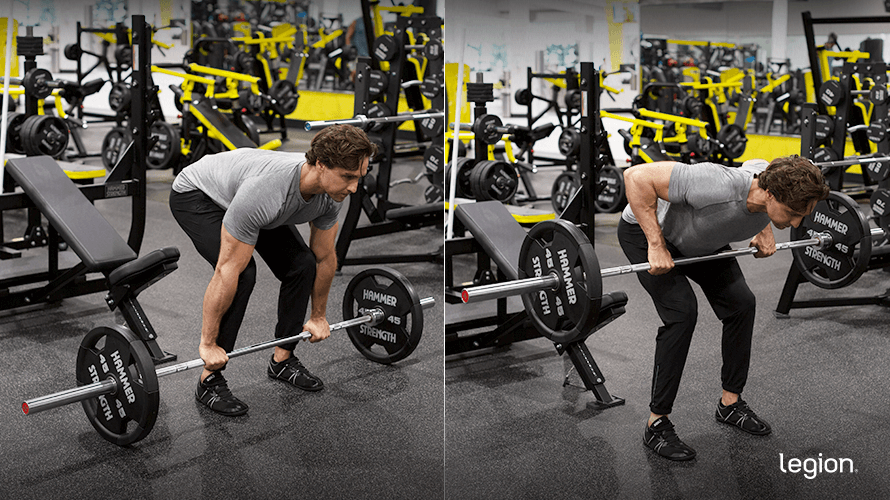
You can generally lift more weight with the barbell row than you can with other rear delt exercises with a barbell, which means it’s ideal for building muscle and gaining strength.
How to:
- Position your feet under a loaded barbell about shoulder-width apart with your toes pointed slightly outward.
- Bend over and grab the bar with a slightly wider than shoulder-width grip and with your palms facing toward you.
- Straighten your back and raise your hips until your back is roughly parallel to the floor.
- Initiate the movement by driving through your legs, then, using the momentum generated by your lower body, pull the barbell to your upper body, touching it anywhere between your lower chest and belly button.
- Once the bar touches your body, reverse the movement and return to the starting position.
2. One-Arm Dumbbell Row
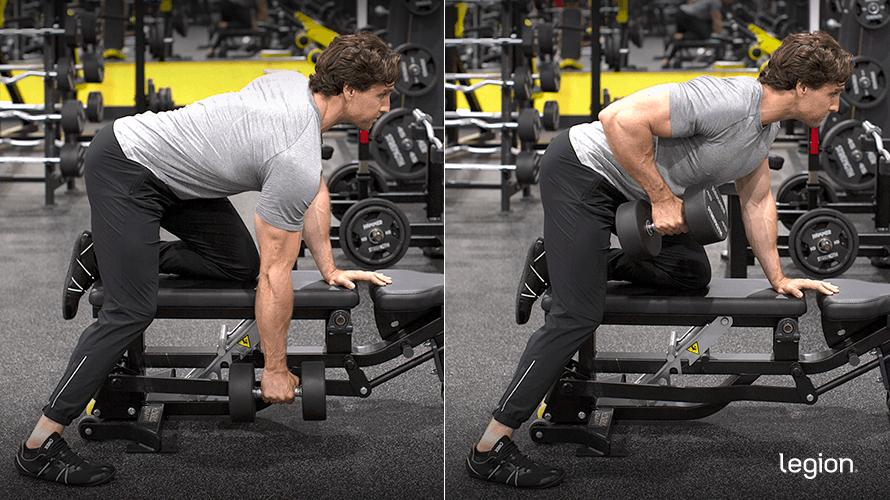
The one-arm dumbbell row is one of the best rear delt exercises with dumbbells because it trains each side of your body independently. This allows you to lift more weight per side than what would be possible during a barbell row, which is generally better for muscle growth.
How to:
- Hold a dumbbell in your right hand.
- Plant your left knee and arm firmly on a bench, your right foot on the floor a foot or two from the bench, and let your right arm (the one holding the dumbbell) hang straight down toward the floor).
- Keeping your back straight, pull the dumbbell upward until it touches your torso, and then return the dumbbell to the starting position.
- Once you’ve completed the desired number of reps, repeat the process with your left arm.
3. Pull-up
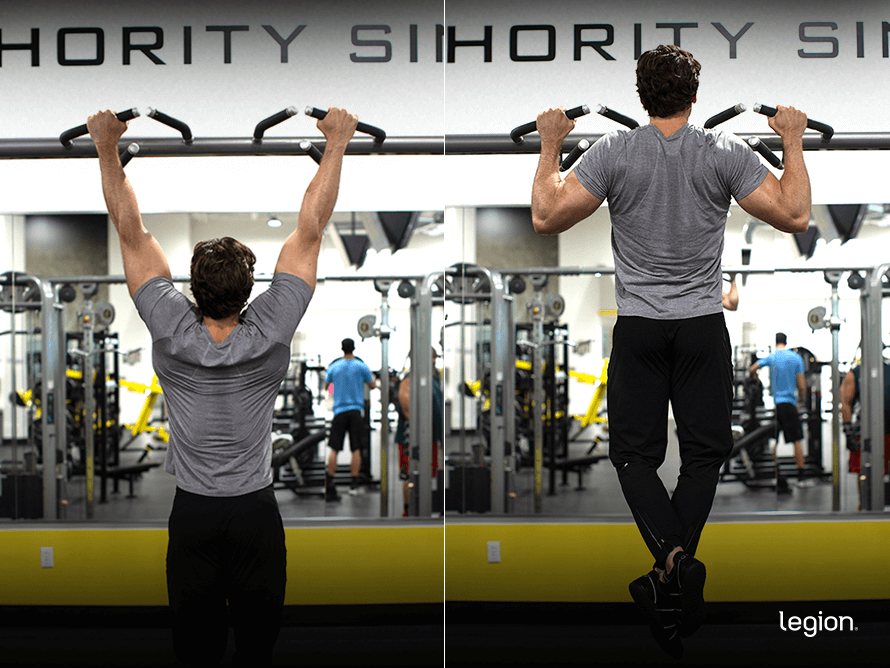
The pull-up is a fantastic bodyweight rear delt exercise that’s ideal if you have very little equipment available.
How to:
- Grab a pull-up bar slightly wider than shoulder-width apart with your palms facing away from you.
- Lift your feet so that you’re hanging with your arms straight. You can cross your feet over each other if you prefer.
- Without swinging your feet or knees, pull your body up until your chin is above the bar.
- Once your chin has passed the bar, lower yourself under control to the starting position in a reverse motion. Keep lowering yourself until your arms are straightened and feel a deep stretch in your lats.
(Tip: a helpful cue for this exercise is to imagine pulling your elbows into the floor).
4. Chin-up
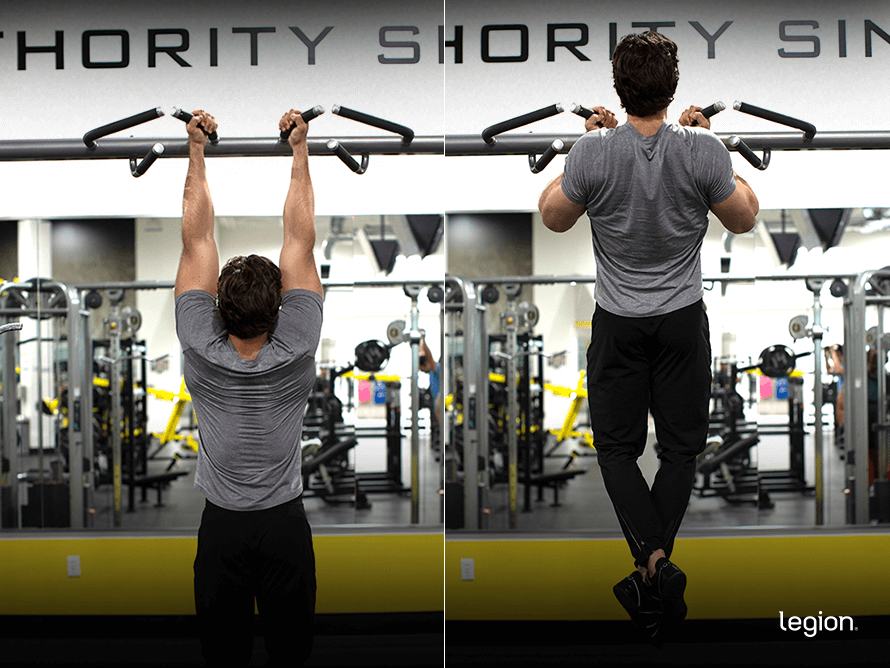
Like the pull-up, the chin-up is one of the best bodyweight rear delt exercises you can do. What makes them slightly different, though, is that the chin-up allows you to train the muscle through a larger range of motion, which is generally superior for muscle growth and strength gains.
How to:
- Grab a pull-up bar with your hands around shoulder-width apart and your palms facing toward you.
- Lift your feet so that you’re hanging with your arms straight. You can cross your feet over each other if you prefer.
- Without swinging your feet or knees, pull your body up until your chin is above the bar.
- Once your chin has passed the bar, lower yourself under control to the starting position. Keep lowering yourself until your arms are straightened and feel a deep stretch in your lats.
5. Lat Pulldown
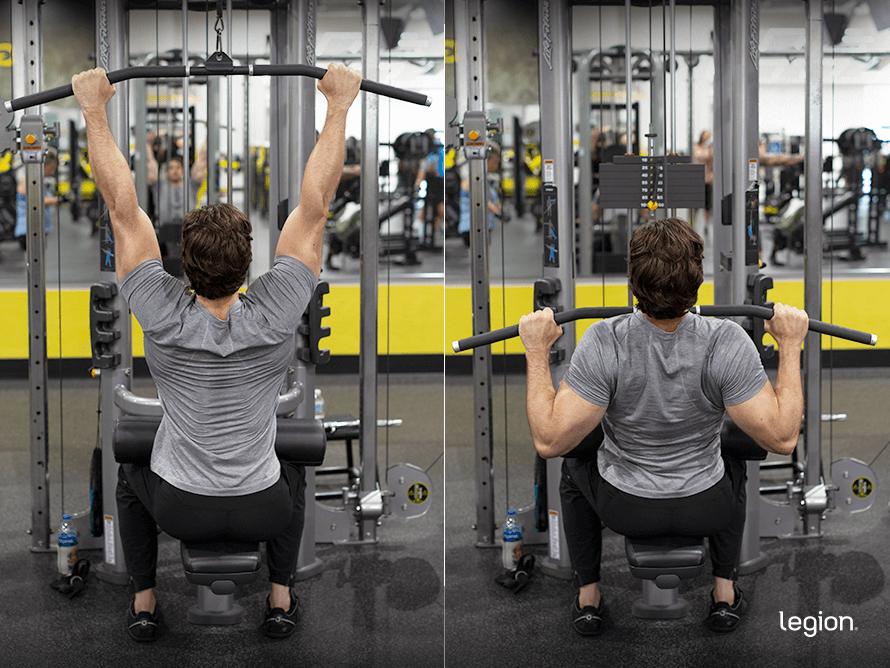
The lat pulldown is an excellent exercise for training your back and rear delts, especially if you’re a beginner and don’t quite have the upper-body strength to do pull-ups.
How to:
- Adjust the thigh pad so that it locks your lower body in place.
- Stand up and grab the bar. While keeping your grip on the bar and your arms straight, sit down, allowing your body weight to pull the bar down with you. Nudge your thighs under the pads and plant your feet on the floor.
- Pull the bar toward your chest.
- Once the bar is underneath your chin (or touches your chest, if you want to make the exercise harder), reverse the movement and return to the starting position.
6. Seated Cable Row

One benefit of doing cable rear delt exercises like the seated cable row is that the cable offers constant tension throughout the set, which stimulates your rear delts slightly differently to other free-weight back exercises.
How to
- Sit down and place your feet on the foot-rest while maintaining slightly bent knees.
- Lean forward and grab the handle, then lean back with your arms stretched in front of you.
- Straighten your back and pull the cable toward your stomach.
- Once your hands touch your torso, reverse the movement and return to the starting position.
7. Barbell Rear Delt Row
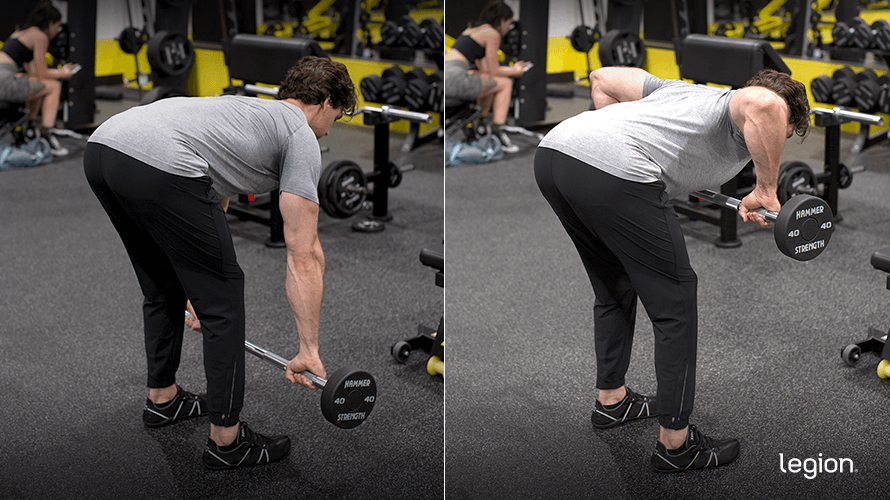
The barbell rear delt row is similar to the barbell row except that you pull the weight to your mid chest instead of your stomach. This reduces the amount your lats contribute to the exercise, and makes it more taxing on your upper back and rear delts.
How to:
- Position your feet under a loaded barbell about shoulder-width apart with your toes pointed slightly outward.
- Bend over and grab the bar with a slightly wider than shoulder-width grip and with your palms facing toward you.
- Flatten your back so that it’s roughly parallel to the floor and let your arms hang straight down.
- Pull the barbell to your mid chest, making sure to flair your elbows at about a 60-degree angle relative to your body.
- Once the bar touches your body, reverse the movement and return to the starting position.
8. Dumbbell Rear Lateral Raise
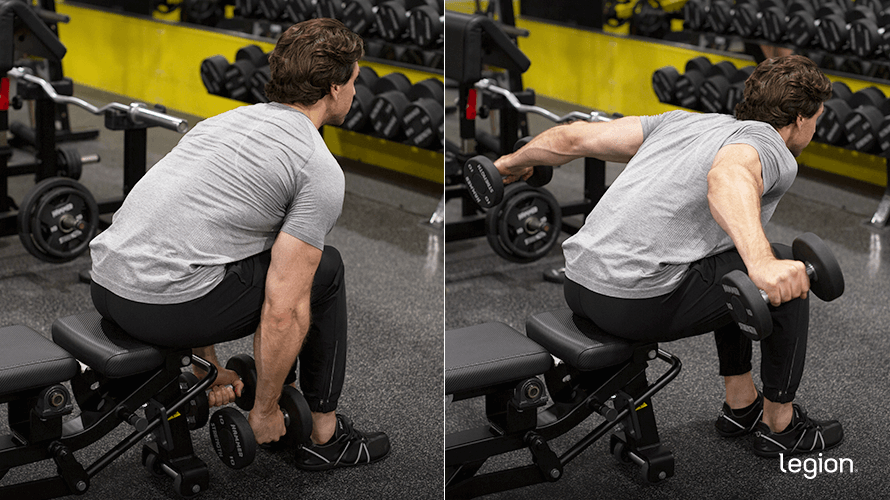
As well as being one of the best dumbbell rear delt exercises, the dumbbell rear lateral raise effectively trains the traps and rhomboids.
How to:
- Whether standing or seated, bend at the hips so that your upper body is as close to parallel to the floor as possible.
- Hold a dumbbell in each hand, and while keeping your back flat, lift the dumbbells out to the side until your upper arm is parallel to the floor.
- You don’t have to keep your arms perfectly straight—having a small bend in your elbows is normally more comfortable.
- Reverse the movement and return to the starting position.
9. Machine Reverse Fly
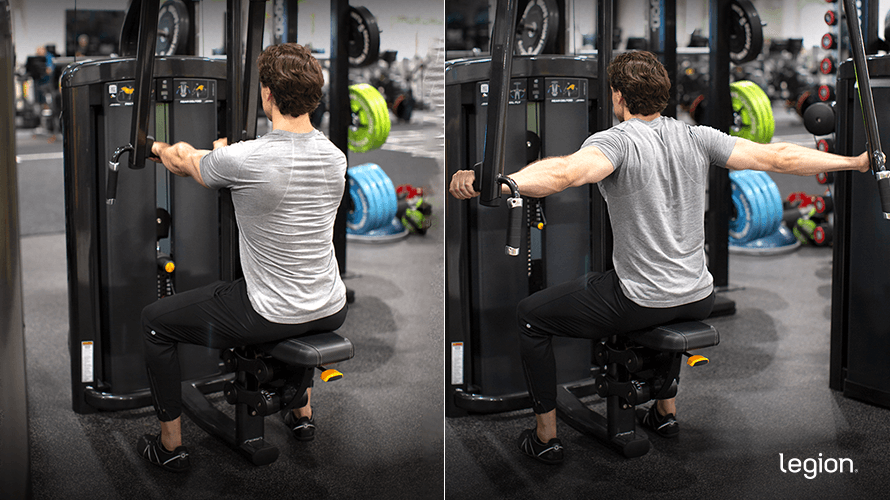
Research shows the machine reverse fly activates the rear delts more than exercises like the seated cable row and lat pulldown. This doesn’t necessarily mean it’s more effective than these exercises for developing your rear delts (especially since you can use far less weight with the machine reverse fly), but it’s a viable alternative.
How to:
- Sit down with your body facing the machine and your feet firmly on the floor. The handles should be at the same height as your shoulders.
- Grab the handles with your palms facing down and press your chest against the pad. While maintaining a slight bend in your elbows, move the weight back in an arc until your arms are directly out to your sides (or slightly behind your body).
- Reverse the movement and return to the starting position.
10. Face Pull
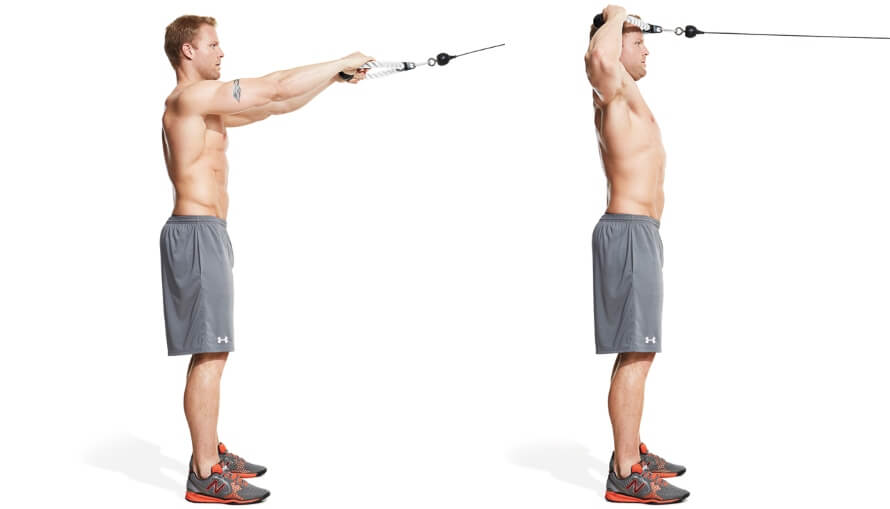
Technically speaking, the face pull trains horizontal shoulder abduction and external rotation simultaneously. This means it strengthens the shoulder and back muscles (including the rear delts) that are responsible for pulling horizontally toward your face and rotating your arm so your forearm points upward, which is difficult to do with any other exercise and may




